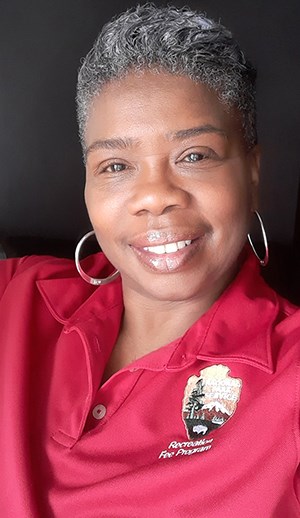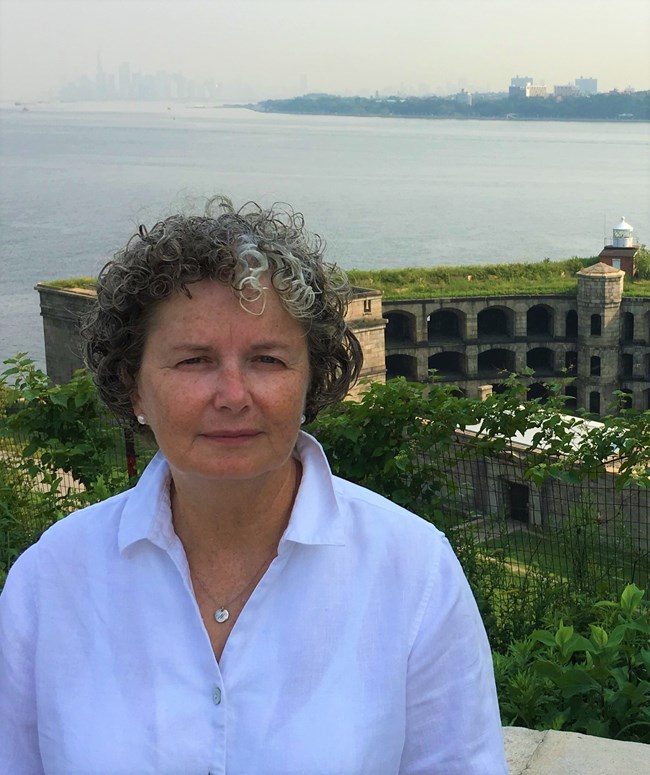-
Bonnie Halda
Bonnie Halda, chief of Preservation Assistance for Region 1, discusses the many firsts she accomplished during her career with the National Park Service. This video is part of Region 1's Women in the National Park Service series.
- Duration:
- 2 minutes, 8 seconds
-
Rochelle Williams
Rochelle Williams is the assistant to the Deputy Regional Director of Region 1. She notes how the work of suffragists, both well known and some that should be better known, helped create more opportunities for women like her.
- Duration:
- 1 minute, 57 seconds
-
Sara Karpinski
Park Ranger Sara Karpinski works at Independence National Historical Park. She speaks about how the variety of tasks in her job keeps things interesting.
- Duration:
- 2 minutes, 28 seconds
-
Sara Falch
Park Ranger Sara Falch meets people from all over the world, thanks to her job at Independence National Historical Park. She enjoys sharing America's history with others as well as learning about the visitors themselves.
- Duration:
- 1 minute, 27 seconds
-
Therese Picard
Therese Picard is the chief ranger for law enforcement at Acadia National Park. Her job changes from day to day, so she is never bored.
- Duration:
- 1 minute, 38 seconds
-
Luisa Dispenzirie
When Luisa Dispenzirie tells her old friends that she works as a curator in an historic building, they nod their heads. After all, her mother worked for the Smithsonian. When they find out that she works at Fredericksburg and Spotsylvania National Military Park, however, they are surprised.
- Duration:
- 2 minutes, 11 seconds
-
Maryann Zujewski
Maryann Zujewski discovered her career with the National Park Service "by accident," but enjoys telling the untold stories at her site. She looks forward to a more diverse NPS that can better reflect and tell the stories of all Americans.
- Duration:
- 1 minute, 50 seconds
-
Nora Halloran
Nora Halloran began her career by volunteering and interning at various historic sites. What she enjoys about her job is watching a visitor have a personal emotional experience with the history of her site.
- Duration:
- 2 minutes, 4 seconds
-
Amanda Babson
Unlike many NPS employees who work at national park sites, Amanda Babson works out of the University of Rhode Island, where she studies the effects of climate change on national parks. She is especially inspired by suffragist Eunice Newton Foote, who theorized in 1856 that increases in carbon dioxide gases would change the earth's temperature. Learn more at https://www.climate.gov/news-features/features/happy-200th-birthday-eunice-foote-hidden-climate-science-pioneer.
- Duration:
- 2 minutes, 3 seconds

NPS Photo
Debbie Davis
I have worked for the National Park Service since 1989. I am currently a Program Analyst and provide support and advise Program Managers in planning and managing their programs, operations and processes. I also conduct research, analyze data, identify trends and track and evaluate the daily operational and program performance of a 10 million plus budget. This turned out to be more than just a job for me – over the years I have met some of my closest friends and I can honestly say, that I am proud to be a part of the NPS family.
As a child I wanted to be an accountant. I have always had a passion for math and numbers. Also, as far as I could remember every job that I held I always ended up with the task of recording journal entries, conducting bank reconciliations or tracking expenses.
With gender discrimination still a relevant issue today, it is so important for women to not only vote, but also vote for their best interests to try and enact changes. My granddaughter is a lesbian, so I am mostly inspired for the steps taken and the changes made with the LGB rights.

Marilou Ehrler, R.A., Historical Architect, Chief of Cultural Resources, Gateway National Recreation Area (GATE)
As the chief of cultural resources, I oversee the protection of over 600 historic structures in nine historic districts in two states, cultural landscapes, archaeological sites, and a museum collection with well over 600,000 artifacts. I joined NPS in 2008 as a term in the regional historic architecture program, accepted a permanent position at GATE as a historic architect in 2011 and became the chief of cultural resources in 2014.
§ What were you doing before you came to the NPS?
Before joining NPS, I was an associate in a private architectural firm. My work focused on historic preservation, including the restoration, rehabilitation and reuse of historic buildings. My projects varied in size from historic houses to airports. The most notable building I worked on was the expansion of Dulles Airport, which was listed on the national register for its architectural significance before it was 50 years old. As the historic preservation consultant, I spent time in a high reach on the building’s iconic façade with a paint conservator trying to determine what color “Dulles gray” really was. In a strange twist, I also worked on the Historic Structure Report for the Lighthouse Keeper’s Quarters at Sandy Hook, a unit of GATE; now I help to protect this National Historic Landmark.
§ What would most surprise people about your career path?
I began my career as a general architect designing office buildings, educational buildings, and even an ice rink but after working on a historic reuse I was hooked and decided to go back to school for historic preservation. I was told by a former professor that I did this “backwards”. Many people join NPS just after completing their preservation degrees. I had a career in private practice, obtained my architectural license, gained experience in historic preservation and then joined NPS. I joined NPS to broaden my perspective and experience, while working for the organization that sets the standards for preservation.
§ What inspires you?
Continuing to learn and explore, expanding my knowledge and my perspective. I have one of Elenore Roosevelt’s quotes over my desk at home: “The future belongs to those who believe in the beauty of their dreams”. I am always thinking about what’s next, what I would like to do next; setting goals for myself and now my division; thinking about what the park cultural resources and the division needs; looking at how we do things and exploring new alternatives – dreaming if you will. Learning new skills, inspires me; learning new skills keeps me thinking and engaged. I admire those who do the same.
§ What do you like most about your job?
The diversity, no two days are the same. Before leaving the region where I worked with many parks and private practice where I juggled many clients and projects, I was concerned that working in one park, I would not be challenged. I was certainly naïve about working in a park and certainly about working in a park like GATE. Given GATE’s size, the variety of its resources, the diversity of its projects, and its complexity, GATE has proven to have many challenges and has provided many opportunities. I love problem solving and at GATE, I am always doing that. During my time at GATE, when it was clear that there was not enough funding to tackle all of our cultural resource needs, I worked to prioritize our resources to guide the focus of our funding and efforts, and I looked at ways to adapt our resources to climate change after superstorm Sandy. I also work with park staff and potential lease holders, to look at things differently and to find new ways to do what is needed or required while minimizing the impact on our resources. Looking at things in a new way, solving complex problems, finding new solutions, are all opportunities GATE has provided.
§ How do the suffragists inspire you?
The suffragists paved the way for women to push for equality in job opportunities, pay, education, and the control our own lives and destiny. Regular women fought for what they believed in to give women the right to vote; their fight lead not just to the 14th Amendment but also paved the way for the Equal Pay Act and Title IX. Growing up, I was lucky. I was raised in a house full of women; my dad was the only male in our house. We were raised to believe that we could do anything and be anything we wanted to be. Our parents instilled in us our right to choose our own path. My path was to enter the field of architecture in a time when few women were architects and when the number of men in architecture schools far exceeded the number of women. I joined the field of architecture, became a registered architect (R.A.) and rose through the ranks. At the time, women were accepted in the field, but women did not run firms. Male architects in similar positions were often paid more because they had “families to support” or because they “did not take leave to have children” (quotes from previous supervisors). As a female architect I had more than one contractor look straight at me and ask, “where is the architect?” or others who chose to address the male associate who was with me. The suffragettes inspired me to keep going, to continue in the field of my choice and of my passion.
Last updated: February 14, 2025

